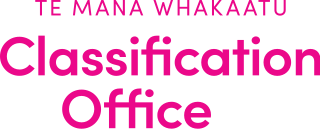A motion picture content rating system classifies films based on their suitability for audiences due to their treatment of issues such as sex, violence, or substance abuse, their use of profanity, or other matters typically deemed unsuitable for children or adolescents. Most countries have some form of rating system that issues determinations variously known as certifications, classifications, certificates, or ratings. Age recommendations, of either an advisory or restrictive capacity, are often applied in lieu of censorship; in some jurisdictions movie theaters may have a legal obligation to enforce restrictive ratings.
Abuse is the improper usage or treatment of a thing, often to unfairly or improperly gain benefit. Abuse can come in many forms, such as: physical or verbal maltreatment, injury, assault, violation, rape, unjust practices, crimes, or other types of aggression. To these descriptions, one can also add the Kantian notion of the wrongness of using another human being as means to an end rather than as ends in themselves. Some sources describe abuse as "socially constructed", which means there may be more or less recognition of the suffering of a victim at different times and societies.
The Canadian Home Video Rating System (CHVRS) is a voluntary rating classification system applied to films on VHS and DVDs. It is administered by the Motion Picture Classification Corporation of Canada, a subsidiary of the Motion Picture Association – Canada (MPA–C). Ratings are "averaged" from ones given by participating provincial film boards: Alberta, British Columbia, Manitoba, Maritimes, Ontario, and Saskatchewan and applied by the distributor to home video packaging.

The Office of Film and Literature Classification, branded as the Classification Office, is an independent Crown entity established under Films, Videos, and Publications Classification Act 1993 responsible for censorship and classification of publications in New Zealand. A "publication" is defined broadly to be anything that shows an image, representation, sign, statement, or word. This includes films, video games, books, magazines, CDs, T-shirts, street signs, jigsaw puzzles, drink cans, and slogans on campervans. The Chief Censor, Caroline Flora, is the chair of the Office.

Reasons for opposition to pornography include religious objections and feminist concerns, as well as alleged harmful effects, such as pornography addiction. Pornography addiction is not a condition recognized by the DSM-5, or the ICD-11. Anti-pornography movements have allied disparate social activists in opposition to pornography, from social conservatives to harm reduction advocates. The definition of "pornography" varies between countries and movements, and many make distinctions between pornography, which they oppose, and erotica, which they consider acceptable. Sometimes opposition will deem certain forms of pornography more or less harmful, while others draw no such distinctions.
The Maritime Film Classification Board is a government organization responsible for reviewing films and granting film ratings in New Brunswick, Nova Scotia and Prince Edward Island.

The 18 certificate is issued by the British Board of Film Classification (BBFC), to state that in its opinion, a film, video recording, or game is suitable only for persons aged 18 years and over. It recommends that no one below that age should be admitted to view a film with an 18 certificate in a cinema, and that 18-rated video recordings should not be sold or rented to anyone below that age.
The TV Parental Guidelines are a television content rating system in the United States that was first proposed on December 19, 1996, by the United States Congress, the American television industry, and the Federal Communications Commission (FCC). The guidelines went into effect by January 1, 1997, on most major broadcast and cable networks in response to public concerns about increasing amounts of mature content in television programs. It was established as a voluntary-participation system, with ratings to be determined by the individual participating broadcast and cable networks.
Censorship in Singapore mainly targets political, racial, religious issues and homosexual content as defined by out-of-bounds markers.

In criminology, public-order crime is defined by Siegel (2004) as "crime which involves acts that interfere with the operations of society and the ability of people to function efficiently", i.e., it is behaviour that has been labelled criminal because it is contrary to shared norms, social values, and customs. Robertson (1989:123) maintains a crime is nothing more than "an act that contravenes a law". Generally speaking, deviancy is criminalized when it is too disruptive and has proved uncontrollable through informal sanctions.

Pornography has been defined as sexual subject material "such as a picture, video, or text" that is intended for sexual arousal. Intended for consumption by adults, pornography depictions have evolved from cave paintings, some forty millennia ago, to virtual reality presentations. A general distinction of adult content is made classifying it as pornography or erotica.

Machismo is the sense of being "manly" and self-reliant, a concept associated with "a strong sense of masculine pride: an exaggerated masculinity". Machismo is a term originating in the early 1930s and 1940s best defined as having pride in one's masculinity. While the term is associated with "a man's responsibility to provide for, protect, and defend his family", machismo is strongly and consistently associated with dominance, aggression, grandstanding, and an inability to nurture. The correlation to machismo is found to be deeply rooted in family dynamics and culture.
Age appropriateness refers to people behaving as predicted by their perspective timetable of development. The perspective timetable is embedded throughout people's social life, primarily based on socially-agreed age expectations and age norms. For a given behavior, such as crawling, learning to walk, learning to talk, etc., there are years within which the behavior is regarded appropriate. By contrast, if the behavior falls out of the age range, it will be considered age-inappropriate. Most people are adhered to these age norms and are aware of whether their timing is "early," "delayed," or "on time."

Bhutan has a low crime rate. Incidents of petty crime are occasionally reported in the country. Violent crime is very uncommon. Some cases of drug abuse are reported; alcohol abuse is a problem. But in general, drug trafficking is low. The most serious threat to Bhutan's security is terrorism by different terrorist groups from neighboring countries illegally camped in the nation.

The British Board of Film Classification (BBFC), previously the British Board of Film Censors, is a non-governmental organisation founded by the British film industry in 1912 and responsible for the national classification and censorship of films exhibited at cinemas and video works released on physical media within the United Kingdom. It has a statutory requirement to classify all video works released on VHS, DVD, Blu-ray, and, to a lesser extent, some video games under the Video Recordings Act 1984. The BBFC was also the designated regulator for the UK age-verification scheme, which was abandoned before being implemented.

Russian Internet restriction bill is a law passed by the Russian State Duma in 2012 which replaced the procedure of shutting down telecom operators by prosecutors' orders with a blacklist of Internet sites containing alleged child pornography, drug-related material, extremist material, and other content illegal in Russia. This blacklist was supposed to be implemented and supervised by a self-regulating NGO of Internet users, but it was never created and this duty was assumed by government agency Roskomnadzor. The bill also introduced several other changes in the law, including liability for providers of telecom services for failing to protect children. Some critics expressed concern that the bill could be used to censor the Internet. Others noted that it would be expensive and, as written, contained many technical problems that would negatively impact legitimate Internet use.

For the Purpose of Protecting Children from Information Advocating a Denial of Traditional Family Values, commonly known as the Russian anti-LGBT law or as the Russian anti-gay law, is a law of Russia. It was unanimously passed by the State Duma on 11 June 2013, unanimously passed by the Federation Council on 27 June 2013, and signed into law by President Vladimir Putin on 30 June 2013.

The Kenya Film Classification Board is a state corporation that operates under the Government of Kenya whose mandate is to "regulate the creation, broadcasting, possession, distribution and exhibition of films by rating them." The Board was founded in 1963 with the commencement of the laws outlined in the Films and Stage Plays Act of 1962 and has since involved itself in the rating and classification of films and television programmes. More recently, it has caused controversy by banning several films, such as the American box office success The Wolf of Wall Street, the Kenyan film Stories of Our Lives, Rafiki, and the 2015 film Fifty Shades of Grey based on the novel of the same name. The Board has also regulated television content, including advertisements.
Adolescents turn to pornography for learning amplified by insufficient sex education, arousal, mating motivations, coping mechanisms, alleviating boredom, entertainment, and to explore their sexual and gender identities. However, they may also encounter content that disturbs them. Without adequate support, they learn to navigate disconcerting material, developing the skills to seek out content that affirms their sexuality while avoiding that which causes discomfort. Without alternative narratives, they think it leads to harmful attitudes about women, sex, LGBTQ people, and people of color, and unrealistic expectations. The use of pornography by adolescents is associated with certain sexual attitudes and behaviors, but causal relationships remain unclear. It can be assumed that adolescents are not passive "fools" or "victims". The typical adolescent consumer of pornography is male, in advanced stages of puberty, sensation-seeking, and often grapples with weak or disrupted family relationships.



















